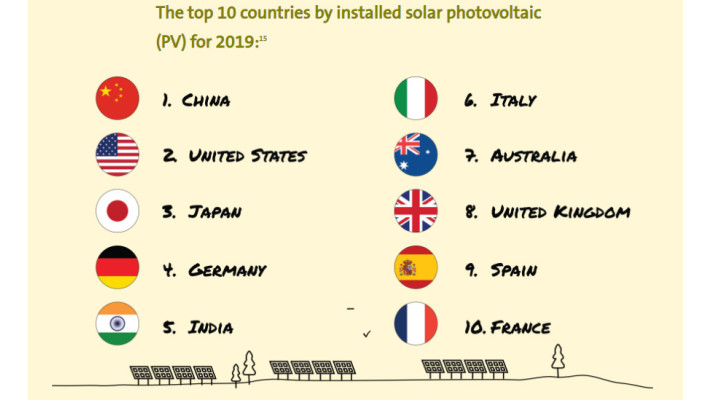The evolution of solar energy
It took centuries for humans to harness and eventually transform the sun's heat into electricity. The early uses of solar energy mostly pertained to heating and cooking. Today, the sun's rays power many gadgets including cars, households, buildings and satellites in space.
How does it work?
A solar panel consists of numerous solar cells made from silicon. A solar cell captures the sun's energy and converts it into electricity. This process is called the photovoltaic effect. Even on a cloudy day, a solar panel will generate some electricity.
Timeline of solar energy
672 BC.
The ancient Chinese use curved mirrors to start fires for warmth and cooking.1
7 BC - 20 AD.
Developed civilisations like the Chinese, Greeks and Romans build south-facing homes for supplementary heating.2
100 - 400 AD.
The emergence of solar water heating. When Roman architect Vitruvius returned from Greece, he notes their advanced solar architecture. This leads to Roman bathhouses featuring south-facing windows (made from transparent materials like mica or glass) to trap in the suns heat and direct it towards bathwater, thereby heating it.2
1767.
Swiss scientist, Horace de Saussure, builds a device coined the 'Hotbox' - a rectangular wooden box with a glass top that can boil water.2 The hotbox is used for cooking food and becomes a prototype for the world's first solar collector - a device that heats water for homes and personal use.
1839.
French scientist, Edmond Becquerel, discovers the photovoltaic effect, the chemical phenomenon of converting light to electricity in a solar cell.3 This monumental discovery will eventually form the foundation of the solar panel.
1860s.
French inventor August Mouchet and his assistant, Abel Pifre, construct the first solar-powered engine by converting solar energy into mechanical steam power.4 Although, Mouchet succeeded, the French government cut his funding and continued using coal-powered engines.
1873.
English electrical engineer, Willoughby Smith discovers the photoconductivity of selenium.5 Three years later in 1876, English physicist William Grylls Adams and his student, Richard Evans Day, discover that selenium produces electricity when exposed to light.6 This will lead to the modern solar cell found in solar panels.
1891.
American inventor, Clarence Kemp, patents the first commercial solar water heater, by improving upon Horace de Saussure's hotbox over 100 years earlier.7
1905.
German theoretical physicist Albert Einstein publishes his paper on the photoelectric effect. This discovery lays the foundation of solar cells.8
1954.
The birth of the solar cell. Daryl Chapin, Calvin Fuller, and Gerald Pearson of Bell Laboratories co-invent the silicon photovoltaic (PV) cell.9 The solar cell is the world's first device that converts light (sunlight or artificial) into electrical power by the photovoltaic effect. The invention allows man to harness enough solar energy to run electrical equipment.
1958.
Launched in the US, the Vanguard 1 satellite becomes the first spacecraft to use solar panels.10
1973.
Researchers from Exxon Corporation design a less costly solar cell, reducing the price from USD$100 a watt to $20 a watt.11 This rectifies the failed attempts in the 50s and 60s to commercialize the solar cell.
1973-present.
Once the solar cell becomes cheaper, a range of consumer goods become solar powered, including calculators, watches and outdoor lights. Plus, solar heating for homes and swimming pools becomes prevalent.
1977.
The U.S. Department of Energy launches the Solar Energy Research Institute, a federal facility dedicated to harnessing the sun's energy.12
1982.
Danish-born Australian Hans Tholstrup drives the first solar-powered car between Sydney and Perth in 20 days.13
2006.
Eccentric billionaire, Elon Musk, founds Solar City. The aim of this company - and companies like it - is to make solar panels more efficient and less expensive while increasing their commercially availability.
The future of solar energy
Solar energy is set to become a bigger component of future electricity generation, with falling production costs and ease of access being the primary drivers of change.
In the International Energy Association's (IEA) latest five-year forecast (2019-2024), renewable power capacity is set to expand by 50%, led by solar PV.14
Historically, many countries have subsidised the costs of solar energy to incentivise its citizens, including Italy, Australia and Germany. As technology advances, the cost of labour and materials may decrease, making solar energy a more affordable option for people to install.
More about evolution of renewable sources on https://www.comparethemarket.com.au/energy/history-renewable-energy/

Sep 28, 2020
https://www.comparethemarket.com
